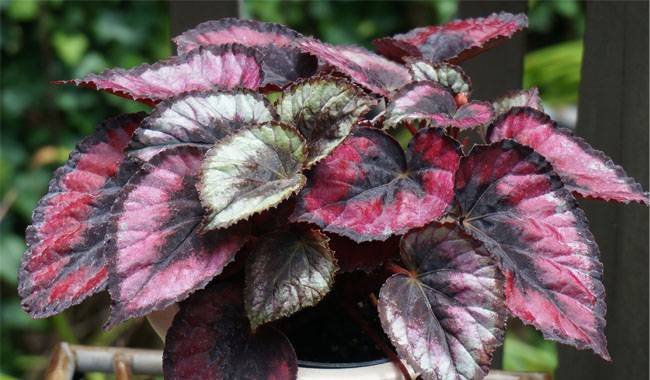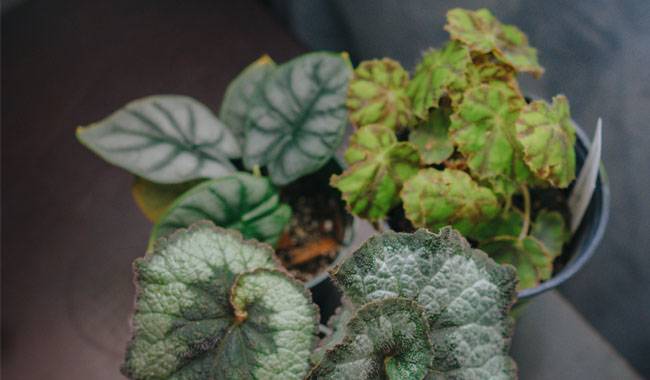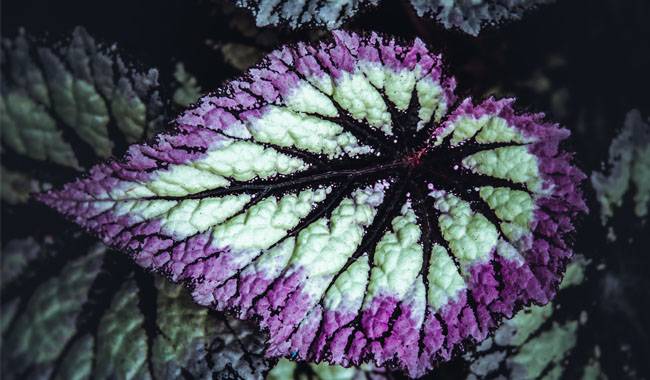
The gorgeous range of colors of Begonia rex foliage is the envy of even the most colorful flower species. Metals, acrylics, powders, spots, and textures mix to form a delightful kaleidoscope, with new varieties to surprise fans every year. If you fall in love with Begonia rex and learn how to care for it properly, you will almost certainly find it a fascinating hobby to create your collection. But finding a way to handle the plant isn’t always easy. Begonia rex is quite sensitive and painful to mistakes, and it’s not just a matter of light and watering.
HYBRIDS AND VARIETIES FROM ONE SPECIES TO AN ENTIRE CLASS
Begonia rex is a legendary species from India, reaching 15 inches (40 cm) tall with asymmetrical leaves up to 12 inches (30 cm) long, horseshoe-shaped spots and spikes, lightly pubescent, and inconspicuous blooms. Today, however, Begonia rex has moved away from their wild ancestors. It is a huge group of hundreds of varieties, often hybrids. It is one of the eight basic cultivar groups of Begonia rex, united more by appearance than by native habitat.
The correct name for modern Begonia rex is Painted leaf begonia cultivars, although names such as painted and king begonia are also very popular. Begonia rex cultorum group, begonia rex plant, and begonia rex cultivars are all the same A beautiful name for Begonia rex, the most popular ornamental foliage variety.
THE LUXURIANT FOLIAGE OF BEGONIA REX
Begonia rex reaches up to 20 inches (50 cm) in room format, but more popular are the compact varieties with a height of 8-12 inches (20-30 cm). The largest leaf size – up to 12 inches (30 cm) long and up to 8 inches (20 cm) wide is rarely reached. As a result, most indoor Begonia rex is twice as compact.
The asymmetrical heart-shaped leaves are hard not to recognize, as well as the serrated margins, sharp apex, curved “snail” base, and prominent veins. The same is true of banded coloring, which is often fringed, spotted, mottled, blurred, and transitional in all possible shades of variation in the variety. Green, red, brown, cherry, white, silver, almost black, simple or with metallic effects, bright or delicate – the colors of the leaves are unique, and their combinations are even more extravagant.
Begonia rex doesn’t bloom at all. And for its sake, it is not worth sacrificing the risk of accelerated aging and compactness by picking off the flower stems as they appear.
SPECIES OF BEGONIA REX
Entire encyclopedias can be devoted to the delightful palette of Begonia rex species and hybrids. Any highly specialized company’s Begonia rex catalog looks like an endless kaleidoscope of colors and shapes. And it is impossible to cover all this diversity in a single survey. It is better to buy and choose Begonia rex according to your taste – in terms of details, shapes, sizes, shades, foliage effects.
The below list is the best and most popular varieties.
- Fairy
This attractive Begonia rex offers silvery foliage with cream and pink shades scattered on the leaves. - Rumba
This stunning specimen displays reddish-green foliage with silvery markings. It can grow up to 8-10 inches tall and wide. - Pink Charming
As the name implies, this beautiful species has lovely pink and green variegated leaves with silvery markings. - Tornado
This exotic Tornado displays dark green foliage highlighted by bronze, silver, and dark purple hues. - Angel Wing
Angel Wing Begonia rex has an upright growth pattern with silvery spots on its winged leaves. It can also produce red flowers. - Duarten
Duarten has pointed leaves with silver and bronze striped patterns. This variety looks lovely on desks and tabletops. - Ballet Rex
Ballet Rex displays fantastic silvery green leaves with medium green edges and a red stem highlighting the entire plant. - Red Kiss Rex
It offers beautiful black-purple foliage with a wide metallic red ring. This elegant Begonia rex grows to 8-12 inches tall and wide. - Silver Limbo
This is a small-leaved, compact variety that displays attractive metallic silver foliage with a red-purple underside. It can reach 6-8 inches tall with the same expansion. - Yamileth
This is a beautiful houseplant with greenish-black foliage and silvery variegation at the edges. - Salsa
Salsa is a variegated variety with silvery leaves with shades of burgundy and green. It can reach a height of 8-10 inches with the same spread. - Spitfire
Spitfire is a gorgeous variety with reddish-pink leaves edged in green and silver. It stays compact and is a great coffee table plant. - Flamenco
Flamenco offers attractive silvery-green foliage decorated with red and green veins. If you want a small, colorful plant, this is it! - Harmony Black Beauty
This small-leaved Begonia rex variety has black leaves with burgundy edges. It has a compact growth habit. - Celia
This Begonia rex displays silvery foliage with black centers surrounded by pinkish hues. The ruffled edges have bright pink and black lines. - Blueberry Sorbet
The medium-sized silvery leaves have a metallic lavender blush near the center. It has a leafy green pattern with chocolate brown markings on the edges. - Champagne Bubbles
This hybrid has silvery leaves with a pink blush. The gray areas of the leaves are covered with silvery bubbles. - Christmas Curl
This gorgeous variety features pink to red foliage with wide green margins with silvery spots. It pairs beautifully with the other varieties on this list. - Fireworks
Fireworks have an upright growth pattern with large vibrant foliage dotted with deep purple centers and pink edges with silvery-white tones in between. - River Nile
River Nile has ruffled, beautiful green foliage with dark bronze edges, creating an attractive display indoors. - Green Gold
Green Gold showcases stunning silvery foliage and dark green veins. New growth has a warm golden sheen and burgundy edges. - Cowardly Lion
This beautiful cultivar has striking chocolate-colored veins on golden foliage. The color of the leaves darkens with age. - Escargot
Snail-shaped leaves with green centers and beautiful gray-green margins are popular Begonia rex hybrids. - Marmaduke
Marmaduke” is very similar to “Cowardly Lion” except that the chocolate hue is splashed on the golden leaves instead of along the leaf veins. - Stained Glass
Eye-catching ruby-colored leaves with dark veins in the center and silvery borders on the edges of the black folds. - Northern Lights
This beautiful, small plant has golden leaves with hints of ochre-brown. It also grows white flowers in winter! - Madame Queen
This hybrid masterpiece has large ruffled borders in olive green with a rich red underneath. - Amelia’s Kaleidoscope
The new growth of this plant has a coppery-blue hue, and when they mature, they take on a rich totemic color – lime. - Plum Paisley
If you like plants with neon hues, then you’ll love this one! It has a mix of blue and green hues. It has a mix of blue, green, and pink with splashes of white. - Solar Flare
This hybrid features orange-red leaves that look spectacular on the plant stand. Its new growth has red shades of foliage.
GROWING CONDITIONS FOR INDOOR BEGONIA REX

Warmth and diffused light – All species of Begonia rex require special, shaded conditions. They are not as hardy as many of their congeners.
Lighting and Placement
To find a suitable location, it is best to concentrate on the western and eastern windowsills, where Begonia rex develops best and enjoys the soft morning or evening sun. It needs diffused soft light. On northern windowsills, which suffer even in summer, the shrub can be moved away from the windows but only slightly in the southern direction. In collections, additional lighting is acceptable, but usually, Begonia rex needs natural light.
Begonia rex grows well in groups, including other plants requiring similar conditions (such as indoor ferns). Placement should be such that the beauty of the foliage is exposed and visible as much as possible: the “cleaner” the background, the better.
Temperature and Ventilation
Begonia rex cannot tolerate temperatures below 60 °F (16°C) and is very sensitive to sudden changes. Even in winter, the optimal feeding temperature is above 64 °F (18°C). However, high temperatures, especially without ventilation and dry air, can also adversely affect plants. Therefore, begonia rex flowers will only be happy if you manage to get the temperature close to the ideal 70-73 °F (21-23°C).
Begonia rex does not like drafts and should not be moved to a balcony or garden because of the risk of overnight frost and the large temperature difference between day and night.
CARING FOR BEGONIA REX AT HOME

Careful watering, stable environment, suitable care for growth – Begonia rex is not as difficult to take care of as rumors suggest.
Watering and air humidity
Begonia rex flowers decay quickly and dry out quickly, so they need constant attention. Water the plant moderately and carefully, but do not let the soil dry out too much or become too wet. It is best not to let the substrate dry only the top layer but to reach a third (or water more frequently, but less often). In winter, reduce watering by about half.
Begonia rex does not like to get wet. They need to be watered very carefully and not sprayed – except in a mist pattern if the procedure is very necessary. The water in the tray needs to be drained directly. And don’t forget that Begonia rex flowers should be watered with soft water, i.e., melted water or rainwater, whenever possible.
Begonia rex flowers prefer a mild, not extremely dry environment, but not too humid either. When the heating equipment is running, it is best to increase the humidity slightly by installing trays, covering the soil with moist charcoal soil adjacent to a fountain or a container with water.
Fertilizer and fertilizer composition
Fertilize Begonia rex only once every two weeks during the spring and summer growing seasons, and only in liquid form.
It is best to use concentrated fertilizer for Begonia rex flowers, or at least you can use fertilizer for ornamental foliage plants.
Pruning and shaping of Begonia rex
To make the bush grow more evenly, more luxuriantly, less quickly deformed, and produce more foliage, Begonia rex royal can be pruned throughout the vegetation’s active period. Damaged, wilted leaves and inflorescences should be removed as soon as possible.
Begonia rex loses its ornamentation, sheds its leaves, loses its compactness when it needs rejuvenation, and often signals its senescence by the growth of new shoots and the balding of old ones. Isolating strong young shoots or re-rooting cuttings is the best way to rejuvenate Begonia rex.
Transplantation, containers, and substrates
Because of its active growth, Begonia rex usually needs to be transplanted annually. If the shrub does not fill the pot space, it can be postponed for a year, replacing the surface soil layer if possible. begonia rex can be transplanted throughout the spring, during the first half of the active growing season.
Choosing the right pot is the key to success. Especially shallow roots and shoots need shallow and wide pots. Even high drainage does not compensate for choosing a pot that is too deep. There is no need to create too much space by increasing the diameter by 1 inch (2.5 cm).
For growing Begonia rex, it is best to look for a special substrate for Begonia rex. If you have good quality ingredients, you can mix your soil with coarse sand or perlite and turf soil (3:1:1) for the leaves. A peat-based soil mix with a loosening agent such as perlite or coco peat substrate will also work. All soils should be supplemented with perlite. For Begonia rex, it is important to control the reaction of the soil mixture to avoid deviating from the optimal slightly acidic pH of 5.0 to 6.0.
To avoid mistakes when transplanting, remember one rule: Begonia rex flowers should be handled very carefully. And never damage the root ball, transplant the plant gently, and be careful not to cause the slightest damage to the above or below ground parts. Neither the shoots nor the root neck of Begonia rex should be flooded.
Pests and problems in cultivation
Begonia rex is very sensitive to improper lighting and care. Lack of light always causes loss of color, elongation, and deformation, while too much direct sunlight can cause numerous burns. The plant also does not tolerate over-watering, such as standing water and soil acidification or soaking due to careless watering or spraying. In drought conditions, the plant will partially die its leaves and cause dry spots.
Begonia rex is highly susceptible to various rots, whiteflies, and powdery mildew. If the plants in your collection are infested, first isolate them. And start preventive treatment with biological agents immediately. Infected Begonia rex will lose its ornamental properties soon. Biocides are too slow, and Royal Begonia rex should be treated with chemical insecticides or fungicides immediately.
Propagation of Begonia rex
Cuttings of Begonia rex roots perfectly in water and perlite, sand, coconut substrate. You can choose the option that suits you. Stem cuttings and individual leaves with petioles or segments with veins and petioles (leaves cut in triangles between the veins, starting from a common point at the base) root fairly quickly, but miniature rosettes grow slowly.
The main thing is to water carefully, sprinkle, not bury the base of the leaves too deeply, provide support above the soil if necessary, and do not forget to build a greenhouse when rooting in the soil.







